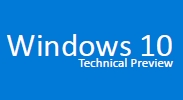Windows 8.x has been generally available since October 26, 2012 and has not received a lot of positive fanfare due to not-so-favourable interface and functionally changes. Microsoft has since changed its tune, is listening to customers and is working on the next version of Windows, Windows 10. One may ask what happened to Windows 9, Satya Nadella the CEO of Microsoft said “it came and went.” Windows 10 Technical Preview (WTP) was released on October 1st, 2014 and is the first release of what will be a number of preview builds leading up to a release sometime in late 2015.
Being an early adopter of alphas and betas, I couldn’t help myself and installed the WTP on my Microsoft Surface Pro 3 without issue. Why not right? That was October 1st. As announced by Microsoft, they are revamping their release process to move from major OS releases every X years to a continuous update cycle where organizations can choose from a cadence of releases. This translates into a 3-tier update plan that allows updates to be released at “consumer speed,” “near-consumer speed” and “long-term.” as described by Michael Silver from Gartner in a Gartner Symposium 2014 Session. This is a welcome change as it escapes the forced Windows 8.1 update and allows organizations to move at an enterprise pace and for consumers to change now. Windows 10 can be considered a progressive elaboration for which Windows will go through a continuous iterative process of refinement and change based on customer insights and feedback combined with Microsoft’s renewed vision of mobile first, cloud first. With that, on October 21, 2014 Microsoft released the first update to Windows 10 technical preview. This release includes 7,000 improvements which come from both Microsoft and from the 250,000 pieces of feedback through the Windows Feedback tool, 25,381 community forum posts, and 641 suggestions in the Windows Suggestion Box, as noted on blogs.windows.com.
Even in its early days, Windows 10 is a refreshing experience. The refinements have corrected the significant flaws in Windows 8, improved upon the general experience and the renewed feature trajectory is certainly in the right direction. Microsoft is finding the balance between the consumer and the enterprise, while keeping mobile first, cloud first top of mind. Based on the widely published features and the evolution that has already occurred in Windows 10, I am optimistic that as Microsoft will deliver on its promise to both consumers and the enterprise. It is obvious that Microsoft has heard the message and has made a course correction in the right direction.
Why the optimism and why the change? Proof in action. The following are a number of major changes that Microsoft has already made and will be making that demonstrate a positive trajectory for Windows:
General Use
- Start menu returns with Live Tiles and flexibility.
- Windows store apps operate in full screen and in a window.
- Action Center for app and system notifications
- Battery Saver to improve battery life.
- Multiple/Virtual desktops is now built-in instead of an add-on.
- Task view to improve app switching
- Applications can now be snapped side-by-side or into a quadrant.
- “Continuum” dynamically switching the user interface on two-in-one devices from desktop to touch.
- Platform unification between Windows PCs, tablets, phones and Xbox One.
Enterprise Use
- Enterprise app store will allow private apps stores and which will enable better software distribution and license management.
- Enterprise lockdown will lockdown PCs to limit app installation and execution.
- Enhanced data encryption through containment and data separation.
- Multi-factor authentication.
- Enhanced rights management
- Easier OS migration and deployment.
To avoid being repetitive, a detailed review of Windows 10 features and updates can be found a number of internet news sites including Paul Thurrott’s Supersite for Windows http://winsupersite.com/windows/windows-10.
Microsoft may have stumbled with Windows 8, but as demonstrated in the past they can turn it around and are. The challenge will be to regain the trust of the community to continue with the renewal and adoption of Windows. With the shift to mobile first, cloud first, Microsoft has diversified its products and services by providing users and organization the ability to leverage investments on multiple devices, platforms and operating systems, as well as an open and flexible cloud platform (Azure) that delivers a lucrative and growing set of services. This move is a game changer for Microsoft and has strengthened their foothold in the marketplace while they evolve their existing core business. I look forward to the evolution of Windows 10 and what it will deliver in 2015.

